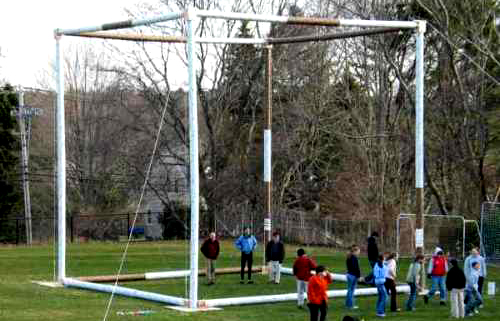
Yes it is a gas but it still has weight. Via Energy Race we can see the work of Dave Ames, from Cohasset, Massachusetts (photo via). He and his students constructed a large cubic volume (27m on a side) that shows what a ton of CO2 gas looks like if it were pure and in a gaseous state. Just like any other gas, if cooled sufficiently, it would solidify and be easier to measure. It would also then condense in the space that it occupied. Picture a ton of water. The same could be heated into steam which is still H20 but just as difficult then to picture as CO2 is at earth’s natural temperatures. Some better explanations can be seen here and here.
This 540 cubic meters of volume of a ton of CO2 represents an average of 15 days for every person living in countries of high per capita emissions. The whole world makes 27 billion of these cubes worth every year through human activity. It equals about 3000km of driving in your car, depending on the fuel efficiency. Of course the problem is that it doesn’t stay in the cube. It mixes with the atmosphere, constantly raising the ppm (parts per million) of CO2 in the overall mix. That number is at 387 ppm as of March 2009. We’ve raised the ppm by 35% since the beginning of the industrial age.
Every year we are collectively adding 10% more to the atmosphere than would be occurring by natural causes (animals, volcanoes, wildfires) which means that the balance has been shifted. The natural CO2 sinks (plants and oceans) can not keep the equilibrium. The excess that is being taken in by the oceans (about 1/3 of the anthropogenic CO2) is lowering the alkalinity of the water (acidification) with serious effect on marine habitats. But what is worse, as ocean temperatures rise, the ability of the water to take in CO2 diminishes, thus leading to a spike in atmospheric levels – a negative feedback loop.
This great site give a lot more information on numbers. For example, each year, the fossil fuel powered electrical generation in the United States creates 6.4 billion of these tons. And each US household’s portion of that electricity use comes to 9.4 tons per house.
If you really wanted to sequester your carbon, you should plant 100 green leafy trees (birch, maple) for EACH ton of CO2 you emit every year. So if you are in the United States, you would have to plant 2,400 trees in your lifetime. Some trees in the tropics can sink carbon at a rate of 40 trees per ton but it is impossible to place an exact number on tons per tree since there are too many variables (soil, sunlight, species, maturity, etc.). 100 trees per ton is a safer bet if you want to be sure. Obviously, every American is not going to plant 2,400 trees (who has 5 empty acres?), so let’s get real about modifying our behavior (individually and collectively) instead. Carbon offset programs that fund reforestation efforts are positive, but will never even come close to scratching the surface of the problem. Five acres of trees per American equals 1,500,000,000 acres – 1.5 billion acres. That’s 6,070,284 square kilometers. That’s 60% of the entire country (and far less area than would be required to fuel the entire world with solar power).
